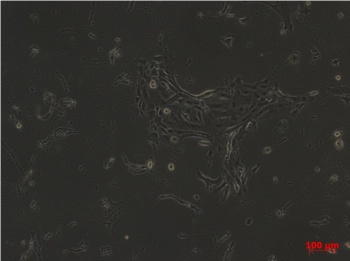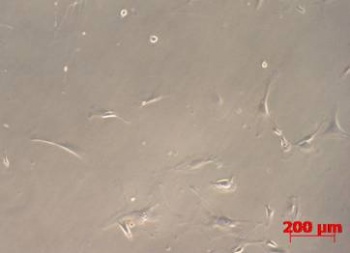Gustavo Satoru Kajitani
From DNA Repair Lab
(Difference between revisions)
| Revision as of 13:52, 25 November 2011 Root (Talk | contribs) ← Previous diff |
Revision as of 13:55, 25 November 2011 Root (Talk | contribs) Next diff → |
||
| Line 1: | Line 1: | ||
| {| | {| | ||
| |- | |- | ||
| - | |[[Image:Satorufoto1.jpg|150px]] | + | |http://www.icb.usp.br/%7Emutagene/images/4/40/Satorufoto1.jpg |
| - | |Lorem ipsum dolor sit amet, consectetur adipisicing elit, sed do eiusmod tempor incididunt ut labore et dolore magna aliqua. Ut enim ad minim veniam, quis nostrud exercitation ullamco laboris nisi ut aliquip ex ea commodo consequat. Duis aute irure dolor in reprehenderit in voluptate velit esse cillum dolore eu fugiat nulla pariatur. Excepteur sint occaecat cupidatat non proident, sunt in culpa qui officia deserunt mollit anim id est laborum | + | |Undergraduate student of Biological Sciences at University of Sao Paulo (USP), coursing the third year. Is currently developing a scientific initiation project under the co-orientation of Carolina Quayle (currently developing her PhD),with the finantial support of FAPESP. |
| <br> | <br> | ||
| Line 9: | Line 9: | ||
| - | == Resumo do Projeto == | + | == Research Abstract == |
| + | |||
| + | The main DNA lesions caused by Ultraviolet (UV) light are the ciclobutane pyrimidine dimers (CPDs) and the pyrimidine (6-4) pyrimidone photoproducts (6-4PP). These lesions may be repaired by different DNA repair pathways. Many species contain genes that encode for photolyases, enzymes that use photons as their energy source in order to specifically repair each of those lesions. However, some groups do not posses the genes that encode for those proteins, such as placental mammals; Therefore, those groups are dependant of other repair pathways, such as the Nucleotide Excision Repair (NER) pathway in order to repair those photolesions. We intend to stablish cell cultures from from transgenic mice deficient in different NER-related proteins that express constitutively either CPD-photolyase or 6-4PP-photolyase, so that we can observe the specific effect of each type of lesion ''in vitro'' after the cells are irradiated with UV light. | ||
| - | Lorem ipsum dolor sit amet, consectetur adipisicing elit, sed do eiusmod tempor incididunt ut labore et dolore magna aliqua. Ut enim ad minim veniam, quis nostrud exercitation ullamco laboris nisi ut aliquip ex ea commodo consequat. Duis aute irure dolor in reprehenderit in voluptate velit esse cillum dolore eu fugiat nulla pariatur. Excepteur sint occaecat cupidatat non proident, sunt in culpa qui officia deserunt mollit anim id est laborum | ||
| - | <br> | ||
| - | Lorem ipsum dolor sit amet, consectetur adipisicing elit, sed do eiusmod tempor incididunt ut labore et dolore magna aliqua. Ut enim ad minim veniam, quis nostrud exercitation ullamco laboris nisi ut aliquip ex ea commodo consequat. Duis aute irure dolor in reprehenderit in voluptate velit esse cillum dolore eu fugiat nulla pariatur. Excepteur sint occaecat cupidatat non proident, sunt in culpa qui officia deserunt mollit anim id est laborum | ||
| <br> | <br> | ||
| <center> | <center> | ||
| + | <br> | ||
| - | [[Image:Transformada.jpg|350px]] | + | http://www.icb.usp.br/~mutagene/images/thumb/2/2a/Queratinocitosatoru.jpg/350px-Queratinocitosatoru.jpg |
| <br> | <br> | ||
| - | legenda | + | Keratinocyte cell culture |
| + | <br> | ||
| - | </center> | + | http://www.icb.usp.br/~mutagene/images/thumb/f/fe/Fibroblastosatoru.jpg/350px-Fibroblastosatoru.jpg |
| + | <br> | ||
| - | http://www.icb.usp.br/%7Emutagene/images/4/40/ | + | Fibroblast cell culture |
| + | <br> | ||
| + | legenda | ||
| - | + | </center> | |
| - | == Research Abstract == | + | |
| - | + | ||
| - | + | ||
| - | The main DNA lesions caused by Ultraviolet (UV) light are the ciclobutane pyrimidine dimers (CPDs) and the pyrimidine (6-4) pyrimidone photoproducts (6-4PP). These lesions may be repaired by different DNA repair pathways. Many species contain genes that encode for photolyases, enzymes that use photons as their energy source in order to specifically repair each of those lesions. However, some groups do not posses the genes that encode for those proteins, such as placental mammals; Therefore, those groups are dependant of other repair pathways, such as the Nucleotide Excision Repair (NER) pathway in order to repair those photolesions. We intend to stablish cell cultures from from transgenic mice deficient in different NER-related proteins that express constitutively either CPD-photolyase or 6-4PP-photolyase, so that we can observe the specific effect of each type of lesion ''in vitro'' after the cells are irradiated with UV light. | + | |
| - | + | ||
| - | + | ||
| - | http://www.icb.usp.br/%7Emutagene/images/2/2a/Queratinocitosatoru.jpg | + | |
| - | + | ||
| - | Keratinocyte cell culture | + | |
| - | + | ||
| - | http://www.icb.usp.br/%7Emutagene/images/f/fe/Fibroblastosatoru.jpg | + | |
| - | + | ||
| - | Fibroblast cell culture | + | |


